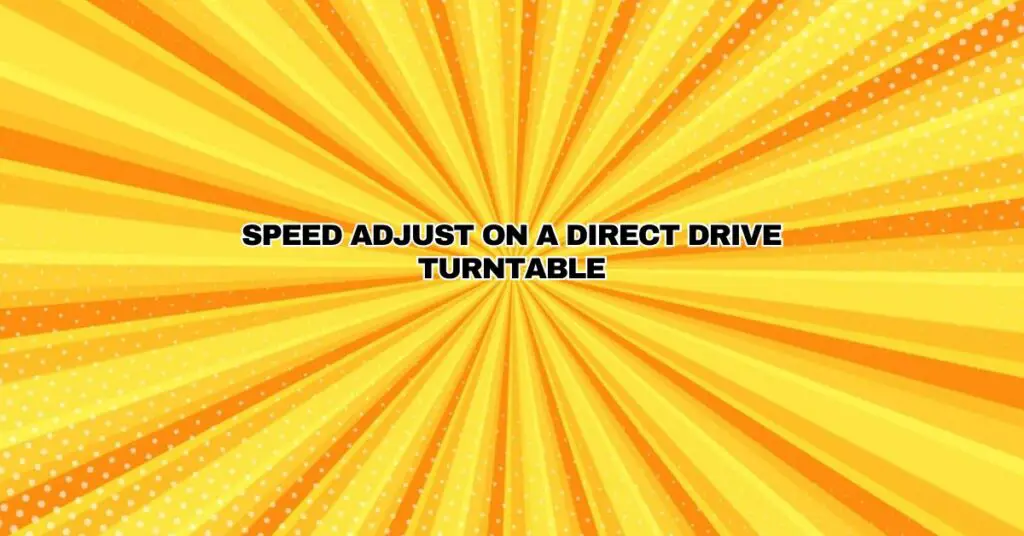Direct drive turntables have earned a special place in the hearts of audiophiles and DJs due to their precision, reliability, and ease of use. One of the key features of direct drive turntables is their speed adjustability. This adjustment allows users to fine-tune the playback speed to ensure it matches the standard 33 1/3 RPM (revolutions per minute) for LPs or 45 RPM for singles. In this comprehensive article, we’ll delve into the world of speed adjustment on direct drive turntables, exploring its significance, the tools you’ll need, the step-by-step process, and common troubleshooting tips.
Why Speed Adjustment Matters:
The accuracy of playback speed is a critical factor for the fidelity of the music on vinyl records. The correct speed ensures that the pitch and timing of the music remain true to the recording. Direct drive turntables offer speed adjustment to account for small variations or drift that may occur over time due to wear and tear, temperature fluctuations, or motor performance changes.
Tools Needed for Speed Adjustment:
Before delving into the speed adjustment process, gather the necessary tools and materials:
- Direct Drive Turntable: You’ll need a direct drive turntable equipped with speed adjustment controls. Ensure that your turntable is in proper working condition.
- Stroboscope Disc: A stroboscope disc is a patterned disc with markings that allow you to visually gauge the accuracy of your turntable’s speed. Many turntables come with a built-in stroboscope, but you can also find aftermarket stroboscope discs for calibration.
- RPM Calibration App: Alternatively, you can use an RPM calibration app on your smartphone. These apps use the phone’s camera to analyze the stroboscope markings and provide real-time feedback on the turntable’s speed accuracy.
- Screwdriver: You may need a screwdriver to access the speed adjustment controls on your turntable. The specific type and size of the screwdriver will depend on your turntable model.
The Speed Adjustment Process:
Follow these steps to adjust the speed on your direct drive turntable:
- Stabilize the Environment: Ensure that your turntable is placed on a stable surface and is not subject to vibrations or drafts. The accuracy of speed adjustment relies on a stable environment.
- Power On the Turntable: Turn on your direct drive turntable and allow it to reach its operational temperature, typically 15-30 minutes. This ensures that the motor is operating consistently.
- Prepare the Stroboscope Disc: If your turntable uses an external stroboscope disc, place it on the platter and secure it with the spindle. Alternatively, if you’re using an RPM calibration app, have it ready on your smartphone.
- Adjust the Speed Control: Locate the speed adjustment control on your turntable. It’s often found beneath the platter, on the turntable’s base, or in a designated compartment. Use the screwdriver to make fine adjustments to the speed control. Turning the control clockwise will increase the speed, while counterclockwise will decrease it.
- Monitor Speed with Stroboscope: With the stroboscope disc in place or using the RPM calibration app, start the turntable and observe the stroboscope markings. If the markings appear stationary or drift clockwise, the speed is too slow. If they drift counterclockwise, the speed is too fast. Adjust the speed control accordingly.
- Repeat as Needed: Make incremental adjustments and continuously monitor the stroboscope markings until they remain stationary. This indicates that the turntable’s speed matches the standard 33 1/3 RPM or 45 RPM. Be patient and make small adjustments to achieve precise calibration.
- Final Check: Once you’ve achieved stable markings on the stroboscope, give the turntable a few rotations to confirm that the speed remains consistent. If everything looks and sounds right, your speed adjustment is complete.
Troubleshooting Speed Issues:
If you encounter problems during the speed adjustment process or find that the speed consistently drifts despite adjustments, consider the following troubleshooting steps:
- Clean the Turntable: Dust and debris on the platter, motor, or speed control components can affect the speed. Thoroughly clean these areas.
- Check for Belt Issues: If your turntable uses a belt to connect the motor to the platter, check the belt’s condition and tension. A worn or loose belt can cause speed fluctuations.
- Inspect Motor Performance: The turntable’s motor may require servicing or replacement if it is responsible for speed inconsistencies.
- Professional Service: If you’re unable to resolve speed issues on your own, consider seeking professional servicing from a qualified technician or turntable repair specialist.
In Conclusion:
Speed adjustment on a direct drive turntable is a crucial process for maintaining the accuracy of vinyl record playback. With the right tools and a methodical approach, you can ensure that your turntable’s speed matches the standard 33 1/3 RPM or 45 RPM, preserving the fidelity and timing of your cherished vinyl collection. Regular calibration and maintenance will help you enjoy a consistently accurate and enjoyable vinyl listening experience.

